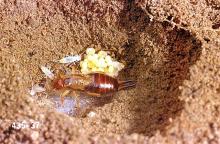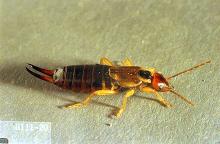Primarily European earwig (Forficula dentata)
Pest description and crop damage Adult earwigs are elongate, flattened, reddish-brown insects about 0.6 inch in length. They are easily identified by their forceps-like pincers on the end of the abdomen. Adults have wings that are kept tucked under a short pair of elytra. Immature earwigs are similar in appearance to adults except smaller, wingless, and lighter in color. They have chewing mouthparts and feed on soft plant tissue causing damage to flowers, leaves and overripe soft fruit.
Biology and life history Earwigs overwinter just below the soil surface as both eggs and adults. In spring, females lay 20 to 50 smooth white- to cream-colored eggs in the soil. Females can often be found guarding eggs and then caring for first instar nymphs. Immatures grow through four to five nymphal stages to become adults by late summer. In fall, females may lay more eggs. Earwigs are active at night. During the day, they hide in moist, shady places such as compost piles or beneath stones, boards, and debris.
Pest monitoring Periodically scout fruit trees for signs of leaf damage. If damage to young leaves is detected, confirm the presence of earwigs by placing corrugated cardboard, flat boards, roofing tiles or similar material on the ground that will provide daytime shelter for the nocturnal earwigs. Check under or within these materials each morning for the presence of the insects. Infestations spread slowly as earwigs rarely fly. For tree-ripened fruit, be sure to monitor earwig populations prior to harvest.
Management-cultural control
Earwigs can be monitored and trapped in small boxes filled with newspaper or straw placed at the base of the tree or in strips of corrugated cardboard strapped around the tree trunk. Earwig abundance can be reduced by removing weeds and plant debris away from the base of trees. Banding tree trunks with plastic wrap covered with sticky adhesive can prevent earwigs from moving into the tree canopy.
Management-chemical control
These treatments target and intercept immature and adult earwigs as they climb into the tree canopy at night.
Management-chemical control: HOME USE
- azadirachtin (neem extract)-Some formulations are OMRI-listed for organic use.
- carbaryl-Highly toxic to bees.
- gamma-cyhalothrin-Highly toxic to bees.
- insecticidal soap-Not recommended for use on yellow-skin nectarine varieties. Some formulations are OMRI-listed for organic use.
- kaolin clay-Repels some insect pests when applied as a spray to leaves, stems, and fruit. OMRI-listed for organic use.
- pyrethrins-Highly toxic to bees. Some formulations are OMRI-listed for organic use.
- spinosad-Toxic to bees. Some formulations are OMRI-listed for organic use.
- zeta-cypermethrin-Highly toxic to bees.
Management-chemical control: COMMERCIAL USE
Spring and summer sprays
- carbaryl (Carbaryl 4L) at 2 to 3 quarts/A. REI 12 hr. PHI 3 days. Apply on trunk and soil around trees. Do not exceed three in-season applications per year. Extremely toxic to aquatic invertebrates; avoid spray drift and runoff to surface waters.





